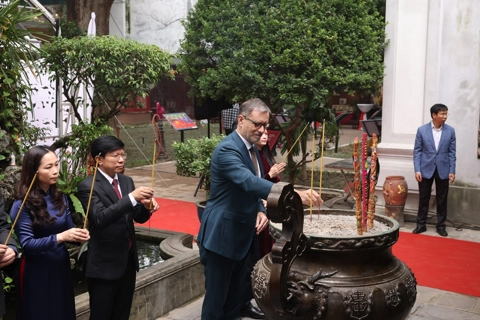Hanoi should expand green space for sustainable urban development: Experts
Hanoi needs to develop green belt through urban agriculture solutions.
The importance of green space, one of the models to ensure sustainable urban development, has been clearly stated in the Master Plan for the Capital Construction to 2030, with a vision to 2050. Experts stressed that Hanoi should expand green space for sustainable urban development.
The Master Plan was approved by the Vietnamese Government in 2011 in Decision No. 1259/QD-TTg which set the orientation for Hanoi's urban development. Accordingly, the metropolitan areas are separated from towns in the suburbs by a green belt.
A worker is watering lawns at Thong Nhat Park in Hanoi’s Hai Ba Trung District. Photo: Do Tam |
Architect Vu Hoai Duc from Vietnam National University- Hanoi, told Hanoimoi that a green belt will be built along the Nhue River in Ha Dong District.
After more than 10 years of implementing the above-mentioned decision, the central urban area has developed rather strongly, while the construction of satellite towns have remained behind schedule.
“Though Hanoi has accelerated renovation of the parks, the efficiency is not as expected. The green belts are mentioned in the zoning plans, but the detailed planning has not been completed,” Duc said.
He noted that the creation of a green belt has not really progressed. Although there are green spaces in some urban centers, no parks have been built in the area planned to build the green belt.
Echoing Duc, Director of the Hanoi Department of Planning and Architecture Nguyen Truc Anh acknowledged that green belt planning in Hanoi has not been focused.
"There are many projects to develop new urban areas in Hanoi, but there are no large-scale park construction projects. Therefore, in the overall adjustment process of Decision No. 1259/QD- TTg, the Government should mention solutions to encourage the development of ecotourism, high-tech agricultural production and natural conservation areas," Anh said.
"It is necessary to take into account the formation of a green belt by developing urban agriculture solutions. Tay Tuu flower village, or Canh orange and Dien grapefruit, famous brands of Hanoi, can become a component of the future green belt, in addition to parks, trees and lake. The tributaries of rivers, lakes and ponds should be protected. In fact, the development of parks, trees and lakes should come from society's private resources," proposed architect Vu Hoai Duc.










